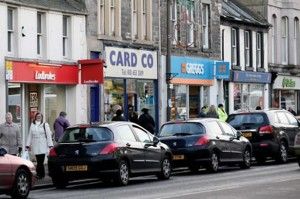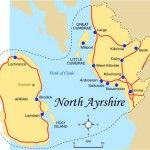On the 16th of August 2001, an article appeared in the Scotsman commenting on the economic position within Scotland. It stated;
“The highest rate of unemployment 9.4% is North Ayrshire … It makes the City of Aberdeen a different country. Unemployment there is down to just 1.7%, the City of Edinburgh is just 2.3%.”
This raised a significant question, Could we really have parts of Scotland being so far apart economically as to be capable of being described as a “Different Country”? The issue of small towns like those in North Ayrshire was recognised by the then Scottish Executive ; “A decade from now if present trends continue, Glasgow will (at least proportionately) no longer be Scotland’s great urban problem; rather it will be the small towns of the West……..there is a wide arc of towns that will be losing some of their economic base, but will be unable to compete with thriving service growth at the core of the City Region.
apart economically as to be capable of being described as a “Different Country”? The issue of small towns like those in North Ayrshire was recognised by the then Scottish Executive ; “A decade from now if present trends continue, Glasgow will (at least proportionately) no longer be Scotland’s great urban problem; rather it will be the small towns of the West……..there is a wide arc of towns that will be losing some of their economic base, but will be unable to compete with thriving service growth at the core of the City Region.
We need a new vision for these towns set in the context of their city-region to deal with these emergent issues.
Review of Scotland’s Cities- The Analysis, Scottish Executive 2002.
So far, so good, the problem was recognised. However, what happened next? Just as the review predicted, a decade later the problem was, relatively speaking, just as bad. In November 2012 Aberdeen City’s unemployment rate was 2.0%, the highest unemployment rates were experienced in North Ayrshire (6.5%) Source NOMIS Jan 2013.
Examining the issue from a different perspective, The 2013 ONS report “Workless Households for Regions across the UK, 2012”, showed that workless households in Aberdeen and Aberdeenshire represented 12.6% of the population whereas in North Ayrshire it was 28%
 Also in 2012, the Scottish Agricultural College produced a vulnerability index for 90 settlements across Scotland “Rural Scotland in focus” which, whilst not claiming to be the only analysis, nonetheless highlighted the issue further. Of the 90, the top ten towns on their vulnerability index were “the small towns of the west”.
Also in 2012, the Scottish Agricultural College produced a vulnerability index for 90 settlements across Scotland “Rural Scotland in focus” which, whilst not claiming to be the only analysis, nonetheless highlighted the issue further. Of the 90, the top ten towns on their vulnerability index were “the small towns of the west”.
The top ten included, in order, Campbeltown, Dunoon, Girvan, Stranraer, Sanquhar, Cumnock, Ayr, Maybole, Castlebay and Kilwinning.
We know the problem; the question is what we do about it. The issue is, I think, three fold.
• The cities review has not really tackled the issue of defining the City Regions, nor has a new vision for the small towns been delivered. All of the towns above could/should be in the Glasgow City region, but will they be? I don’t think it is at all clear that this is the case or what they can expect from the focus on Cities.
• There is evidence that these towns have been in decline for some time. They did not get in this position overnight and yet we seem to expect that the solutions can be short term. Scotland’s Regeneration Landscape is littered with short term projects that have not produced the expected outcomes, perhaps this is because they have not been long term enough. We need political consistency and enough bottle to ensure commitment to long term investment and change, perhaps we need the kind of long term commitment which applies in the Highlands And Islands to be applied to West Central Scotland.
• It is, in some ways understandable that Government investment is applied where it can be seen to deliver short term gains and therefore is often in areas where it complements existing success. Government’s agencies such as Scottish Enterprise’s commitment to “Backing Winners” is, at the Scottish level, laudable insofar as it deliver success for Scotland but growth in, relatively, successful areas does not, as the research shows, trickle down to more disadvantaged areas. In our Scotland of the future we cannot afford continuing the notion that some communities in Scotland are “Different Countries”.
Here lies the challenge. Surf recently hosted a debate on Regeneration and the Referendum both the Yes and No campaigns took part. Both Campaigns sought to persuade that the future was better under their scenarios, all couched in broad terms. What, I think, we are entitled to know is how either camp would design their policies to deliver economic growth for all Scotland and all Scots, how they would ensure that disadvantaged communities could catch up with the more successful areas, for some simply to get to average levels of employment would be a major step forward.
How can all Scotland share in a successful future, The yes and no camps should clearly articulate their vision, I think we deserve to know.
